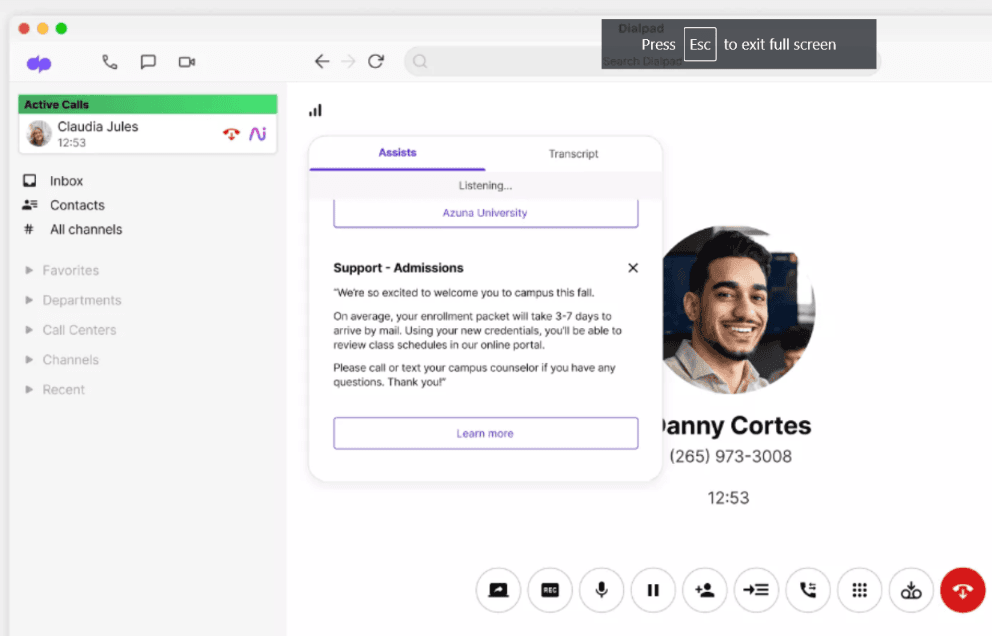MEDDIC sales methodology
You might have a superb sales team, but they won’t close many deals if they’re not talking to the right prospects. They need to know which ones are worth chasing, so that the company’s resources are focused on leads who are likely to convert. That's where MEDDIC comes into play.

You might have a superb sales team, but they won’t close many deals if they’re not talking to the right prospects. They need to know which ones are worth chasing, so that the company’s resources are focused on leads who are likely to convert.It’s both time-consuming and challenging to identify worthwhile leads. But you can improve the process—and shorten your sales cycle—with a specific strategy based on customer qualification. That’s where the MEDDIC sales methodology comes in.
It helps your reps to understand their audience better, by asking the right questions to extract relevant information from prospects. Remember, a higher quantity of qualified prospects matters more than the sheer volume of initial leads.
So, what is MEDDIC selling and how do you do it?
What is MEDDIC in sales?
MEDDIC is a sales qualification framework that works in tandem with your overall sales process to help reps qualify opportunities. It was pioneered in the 1990s by Jack Napoli and Dick Dunkel at technology company PTC, where it’s credited with helping the company to triple its sales in four years.
The methodology is designed for complex sales environments such as B2B sales, with lengthy sales cycles, multiple stakeholders, and solution-based selling.
But what’s the MEDDIC sales meaning? Each letter in the acronym represents a different factor to consider during the process of qualifying leads, helping sales teams to collect valuable information:
Metrics: Which KPIs matter most to the buyer?
Economic buyer: Who has the authority to make financial decisions?
Decision criteria: What’s important to your lead when they’re deciding to buy?
Decision process: How do they make their buying decision?
Identify pain: What are your prospect’s pain points and challenges?
Champion: This is someone in the prospect’s organisation who’s an advocate for your product.
The idea is to ask further questions related to each of the letters. You’ll learn more about each lead and find out if they’re a good fit for your business.
DIALPAD TIP: Alongside MEDDIC, automated lead scoring helps you streamline the qualifying process. It makes it easier for reps to identify highly-qualified leads and know when to communicate with them.
The MEDDIC sales methodology: Stage-by-stage
So, we know what the letters stand for, but precisely what is the MEDDIC sales methodology and how does it work? Let’s have a closer look, stage-by-stage:
Metrics
Metrics enable sales teams to quantify what the potential customer is looking for and how your solution can help.
What do they hope to achieve by investing in a solution? For example, they might say they want a communications system with at least 99.99% uptime, to improve CSAT scores by 30%, or to reduce manufacturing costs by half.
Once your reps know these metrics, they can base the sales pitch around them—using your own stats to prove the ROI of your solution. Let’s say you’re selling a sales productivity tool. It would be relevant to tell the prospect that the tool saves your customers five hours per week on data entry.
Economic buyer
The economic buyer has the authority to make the buying decision. They’re the ones your reps have to convince. This may be someone in a higher position at the company than the initial contact, but it’s important to talk to them directly if possible.
By identifying the economic buyer and getting to know their mindset, your team can ensure they use the right language when talking about your solution.
Decision criteria
It’s likely that your prospect is considering various solutions, so your sales team needs to find out what criteria they’ll use for the final decision. This may involve a range of technical and economic factors. Are they most concerned about price, features, ease of use, or potential ROI?
The prospect may be able to provide guidelines on criteria, so make sure your team requests this. When you know the boxes they need to tick, you can tailor your messaging accordingly. However, not all prospects have defined criteria, which presents a great opportunity to influence them.
Decision process
The next step is to discover how the prospect makes decisions. Is there a structured process with a timeline? Does it involve multiple stakeholders? Does it require formal approval? Again, you can tailor your approach with this knowledge.
It’s important to understand exactly what needs to take place on the prospect’s side, so that you can ensure the relevant conditions are met on your side. It’s best to stay agile, though, because every prospect will have their own operating methods.
DID YOU KNOW?
Dialpad integrates with Google Workspace (among many other apps), so you can create, store and share relevant documents regarding different prospects with ease.
Identify pain
One of the most vital elements of MEDDIC sales methodologies is to develop an understanding of your prospect’s pain points. They might be concerned about poor ROI, frustrated by a clunky legacy system, or keen to reduce time spent on manual tasks.
Reps should ask for specific details, so that they can highlight all the ways in which your solution fixes the problems and makes life easier. They should also explore what will happen if the prospect makes a bad decision or no decision at all—such as lost revenue or risks to their business.
Champion
The champion is your ally within the prospect company, helping you to navigate the internal processes and keep you in the loop with the decision-making process. They’re also an advocate for your solution, so it needs to be someone with enough power and influence to promote it.
Champions are typically the people who are most affected by their company’s challenges, meaning they have much to gain from using your product. But they’ll only champion your cause if the value of your solution aligns with their goals.
How does MEDDIC compare to other sales methodologies?
There are a number of variations on MEDDIC selling. For example:
MEDDIC vs. MEDDICC
This variant adds an extra C to the acronym, which stands for “Competition”. It recognises the importance of knowing your competitors, especially those being considered by your prospect.
This may include both direct and indirect rivals; anyone who is competing for the same resources or budget as you are. It’s your chance to show how your product compares favourably to that of your competitors.
MEDDIC vs. MEDDPIC
The added P here is for “Paper process”. With paperwork and approval chains being a major reason why deals get delayed, it’s vital to understand everything the prospect has to do before making the purchase.
Reps should talk through the paper process with the prospective customer, and make sure both sides are equipped and ready to get contracts and other documentation sorted quickly.
MEDDIC vs. MEDDPICC
This version covers all bases, adding both Paper process and Competition to the original MEDDIC. For complex B2B sales processes, it may be worth using this more comprehensive methodology.
MEDDIC vs. BANT
In BANT sales, the letters stand for Budget, Authority, Need, and Timing.
This is a more basic framework than MEDDIC, breaking down lead qualification into its simplest parts: Can the prospect afford your product, do they have the authority, why do they need it, and how urgent is that need?
How to implement a MEDDIC sales process: 6 best practices
While the MEDDIC sales stages provide a simple framework for lead qualification, there’s a lot more to the process than just ticking off each element on a list.
Here are some best practices to bear in mind as you go:
1. Use open-ended questions
Simple “yes”/”no” questions won’t tell you much about your prospect and their requirements.
Instead, encourage your reps to ask open-ended “ discovery” questions, so that prospects can explain their challenges and pain points in their own words. For example, instead of asking: “Are you frustrated with your existing system?”, ask: “What would you like to change about it?”
2. Listen to the prospect
It’s essential that salespeople pay proper attention to everything the prospect says in order to understand their needs—and also to let them know you value their custom rather than seeing them as a statistic.
It’s good practice, too, to keep a record of what’s said for future conversations. Dialpad Ai can record and transcribe all your calls, and store the information via integration with your CRM.

3. Build relationships
Relationships are a key part of MEDDIC sales processes. It’s important to develop a particularly strong bond with the champion—they’ll guide you through their company’s internal workings, while you’ll guide them through a smooth decision process.
DIALPAD TIP:
Dialpad Ai can provide you with a “relationship view” that displays the entire conversation history with a prospect (or customer).
4. Understand the competition
Whether or not you’re using MEDDICC (with the extra C), it’s worth doing a little research into your competitors.
With knowledge of rivals’ strengths and weaknesses, reps can position your product more effectively. However, they should never actually bad-mouth the competition—this will make your company seem arrogant and unprofessional.
5. Train your team
Before implementing MEDDIC or its variations, make sure your sales team is fully aware of how it should work and why it’s important.
As part of sales training, perhaps you could create a dedicated playbook titled “What is a MEDDIC sales process?”. That could guide reps through the various stages and explain what they must do to succeed. You can also track how well they stick to the methodology.

DID YOU KNOW?
Sales teams need to know how to handle common objections. You can program Dialpad’s Ai to pop up with helpful information when tricky questions come up on prospect calls.
6. Track your progress
Like any new strategy, you need to know that MEDDIC is working well for your business.
It’s important to track and measure relevant metrics to find out if it’s making an impact—and to find ways to improve. If it’s not having the effect you’d hoped, try adjusting it to match your sales cycle and your prospects’ needs.
Is the MEDDIC sales strategy right for your sales team?
The MEDDIC sales technique may suit some businesses and teams better than others. Let’s have a look at the benefits and potential pitfalls:
Advantages of the MEDDIC framework
MEDDIC is a simple way to streamline your lead qualification process, giving sales teams a structured path to follow. It provides the benefits of a checklist, like making the different stages easy to remember and ensuring reps have all the information they need.
It also saves time and money by making sure that reps focus on leads that are more likely to convert. Lost deals often happen because a lead wasn’t properly qualified before entering the sales funnel, and MEDDIC aims to prevent this. As mentioned, it’s especially useful for B2B sales.
MEDDIC helps reps to develop a deeper understanding of prospects’ pain points and decision-making processes. Otherwise, they’re just guessing—and they won’t know why a deal was won or lost. The knowledge gained through qualification is also useful when a lead becomes a customer.
Drawbacks of the MEDDIC framework
Implementing MEDDIC can be resource-intensive, with plenty of time and effort needed for collecting, recording, and analysing information for each prospect.
You’ll also need to make time for training your reps, so that they know what to do if a prospect is uncommunicative. Dialpad’s live coaching tools can be helpful here.

For instance, Real-Time Assist (RTA) cards can provide reps with prompts guiding them toward getting the information they need.
The MEDDIC framework is also fairly rigid, so you have to be careful that the emphasis on process doesn’t prevent an organic conversation. Some scenarios might not adhere to the MEDDIC categories, and reps need to know that it’s okay to use their initiative to win the prospect’s trust.
Plus, if your sales are generally simple and transactional (such as B2C sales), you might not need the full MEDDIC methodology. In fact, following it could make the process less efficient. You could be better off with BANT in those cases.
The right collaboration platform can support any sales methodology
Whether you choose to use the MEDDIC sales framework or something else, it definitely helps to have the right platform in place for communication and collaboration; like Dialpad.
With all your sales communications in one place, it’s easy for remote and hybrid teams to stay connected on any device, from anywhere. Plus, reps can personalise interactions with prospects and customers by giving them a choice of channels for convenience.
Dialpad’s customer intelligence platform gathers detailed data and analyses it using artificial intelligence and machine learning. Sentiment analysis helps you decipher what prospects are really saying, while calls are transcribed with speech recognition technology.
You can ensure your team knows what’s what with Dialpad’s sales coaching tools, too. These include live transcripts, call recordings, and RTA cards to guide reps through difficult conversations. In short, you’ll have everything you need to make MEDDIC a success.
MEDDIC sales FAQs
Apply the MEDDIC methodology to all your calls with Dialpad
Dialpad Sell Centre allows you to add Ai Playbooks so that when your team can follow this methodology during sales calls and improve their win rates. To learn more, book a demo, or take a self-guided interactive tour of the app first!
